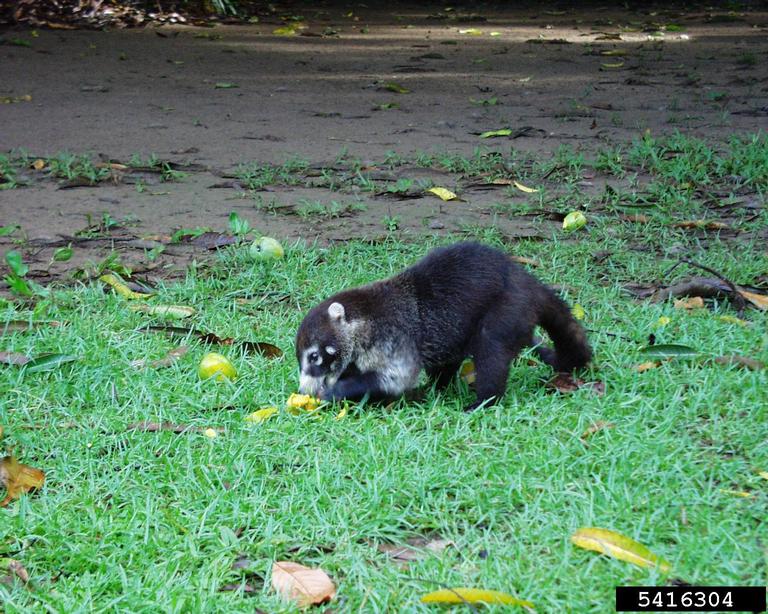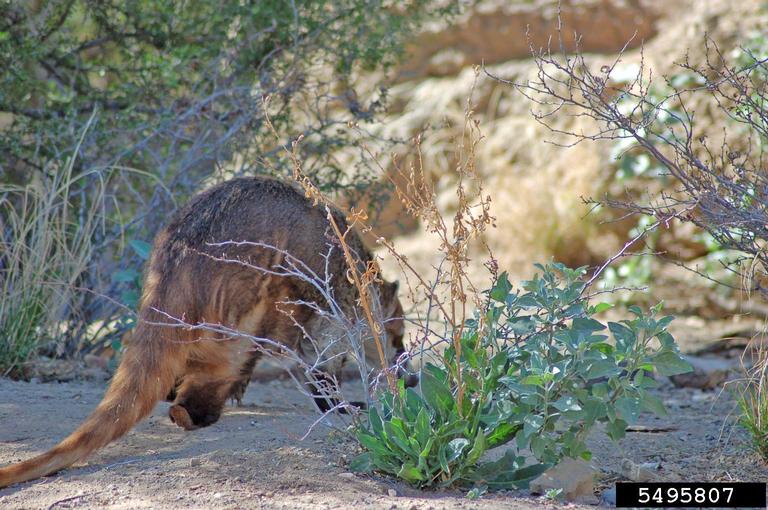 Coatimundis in the Verde Valley - April 11, 2018 Jeff Schalau, Agent, Agriculture & Natural Resources University of Arizona Cooperative Extension, Yavapai County As I was coming down I-17 along Copper Canyon into the Verde Valley recently, I saw a coatimundi trying to run across the northbound lanes. Luckily, it turned back and narrowly escaped injury. I had been hearing anecdotal reports of coatimundis in the Verde Valley for several years now. However, not having seen one for myself, I was skeptical. Now, I’m a believer. The animal I saw was a white-nosed coati (Nasua narica also commonly known as a coatimundi). The white-nosed coati is native to woodland areas of Central America, Mexico, and the southern United States. It is related to raccoons and ringtails but has a long snout and long, slender tail. Like the raccoon, it also has a dark facial mask and faint rings on its tail. White-nosed coatis have short legs with elongated front claws for digging and walk “flat-footed” like bears and humans. The White-nosed coati is diurnal (active during daytime) and prefers woodland and riparian habitats. They also like rocky canyons. People often observe them in southern Arizona’s scenic canyons (Aravaipa, Madera, Ramsey, and others). Past anecdotal sightings have been recorded in Prescott too. Given their habitat preferences, it seems they have found a perfect habitat in the Verde Valley. White-nosed coatis spend considerable time foraging on the ground, but they climb trees as easily as a squirrel. Their long tail seems to function like that of a squirrel helping them maintain their balance. White-nosed coatis often live in mobile groups consisting of adult females, yearlings, and babies. Adult males are usually solitary most of the year. Coatis are omnivorous consuming insects and other ground-dwelling arthropods, lizards, snakes, carrion, rodents, nuts and fruits of native trees, prickly pear, and yucca. White-nosed coatis are believed to be fairly recent immigrants in Arizona. Some think their range extension from the mountains of northern Mexico was facilitated by the ready availability of carrion after the catastrophic drought and subsequent death of hundreds of head of cattle in the early 1890s. The first recorded Arizona specimen was taken from the Huachuca Mountains in 1892. Other sources surmise climate change could be a factor in their northerly advance. For wildlife enthusiasts and tourists, these new residents provide excellent opportunities for observation. As with any wildlife species, it is unlawful to feed them (ARS 13-2927). Feeding wildlife usually results in the wild animal becoming habituated to human foods: a situation that never ends well for wildlife. Please resist the urge to feed wildlife other than birds. While occurrences are rare, white-nosed coatis have also been known to contract rabies. As with wildlife observation of any species, viewers should keep their distance and not try to interact directly with coatis. If any wildlife species is behaving uncharacteristically, contact animal control and/or the Arizona Game and Fish Department. For farmers and gardeners, preventing crop damage by white-nosed coatis may prove challenging. They can easily climb fruit trees and fences that protect cultivated areas. I would imagine an electric fence would dissuade them when correctly placed. There are many fence designs and materials available for excluding raccoons. These should also be appropriate for excluding coatis. The designs I’ve seen include: three hotwires spaced about four inches apart around the perimeter; one hotwire at the top of an existing fence; and electric poultry mesh. Having dogs that are free to roam the perimeter of cropped areas may also provide some protection from white-nosed coatis. Raccoons often elude dogs because the raccoon is nocturnal and dogs normally sleep at night. Being diurnal, white-nosed coatis may be more likely to be kept away by vigilant domestic dogs. People are sometimes tempted to keep raccoons and coatis as pets. As with wildlife feeding, trying to domesticated a wild animal is never a good idea and often ends badly for the animal and the human. Watch for the white-nosed coatis in the Verde Valley. Keep your distance and respect their wildness. See below for additional resources and photos. Follow the Backyard Gardener on Twitter – use the link on the BYG website. If you have other gardening questions, call the Master Gardener help line in the Camp Verde office at 928-554-8992 or e-mail us at verdevalleymg@gmail.com and be sure to include your name, address and phone number. Find past Backyard Gardener columns or provide feedback at the Backyard Gardener web site: http://cals.arizona.edu/yavapai/anr/hort/byg/. Photos  Juvenile white-nosed coati (Nasua narica, Caleb Slemmons, National Ecological Observatory Network, Bugwood.org).
Juvenile white-nosed coati (Nasua narica, Caleb Slemmons, National Ecological Observatory Network, Bugwood.org). Adult South American coati (Nasua nasua, Joy Viola, Northeastern University, Bugwood.org).
Adult South American coati (Nasua nasua, Joy Viola, Northeastern University, Bugwood.org).Additional Resources Coatimundi Nongame Field Notes - Arizona Game and Fish Department www.azgfd.gov/i_e/ee/resources/field_notes/mam/coatimundi.pdf White-Nosed Coati Friends of Madera Canyon www.friendsofmaderacanyon.org/sp-spot%20coati.html White-Nosed Coati The Mammals of Texas - Online Edition www.nsrl.ttu.edu/tmot1/nasunari.htm Seven Ways to Safely Watch Wildlife National Park Service www.nps.gov/subjects/watchingwildlife/7ways.htm Pests in Gardens and Landscapes: Raccoons University of California Integrated Pest Management - Look at "Exclusion" section for electric fence recommendations. ipm.ucanr.edu/PMG/PESTNOTES/pn74116.html |